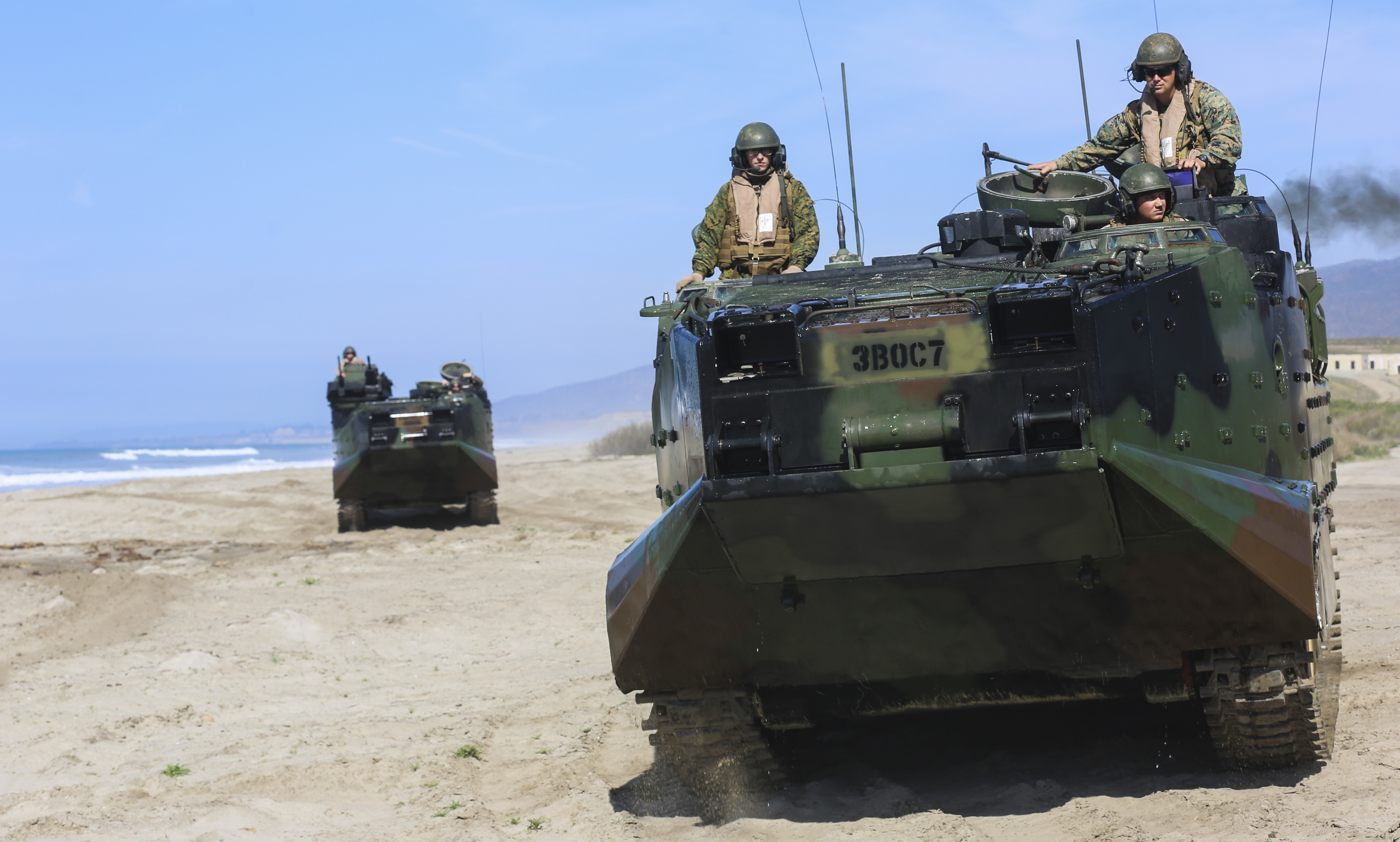
CAMP PENDLETON, Calif. – A dozen amphibious assault vehicles left the USS Somerset (LPD-25) a mile offshore and raced toward the beach Friday in two waves. The night before, a group of Marines and Japanese soldiers rode ashore in combat rubber raiding craft, using speed and surprise to survey and prepare the beachhead in advance of the amphibious landing force.
The mission: Come ashore, establish a beachhead and prepare to assault a nearby island and unseat invading forces from a besieged town of innocent civilians. So on this bright morning, the U.S.-Japanese force hustled up the sandy bluffs to take and secure a nearby “combat town.” The force paired up with additional troops arriving on MV-22 Osprey tilt-rotor aircraft and moved onto the main objective, a nearby “island,” and liberate the town from enemy invaders.
The scenario parallels some of Japan’s biggest concerns. It is rethinking its defense posture in light of China’s growing military might and reach – notably in the South China Sea. With its new defense strategy to assist the U.S. and other allies, Japan is beefing up its defensive capabilities with new forces like a retooled brigade that can conduct combined amphibious operations. Japan, a major U.S. security treaty partner, paired with U.S. Marines a decade ago to help.
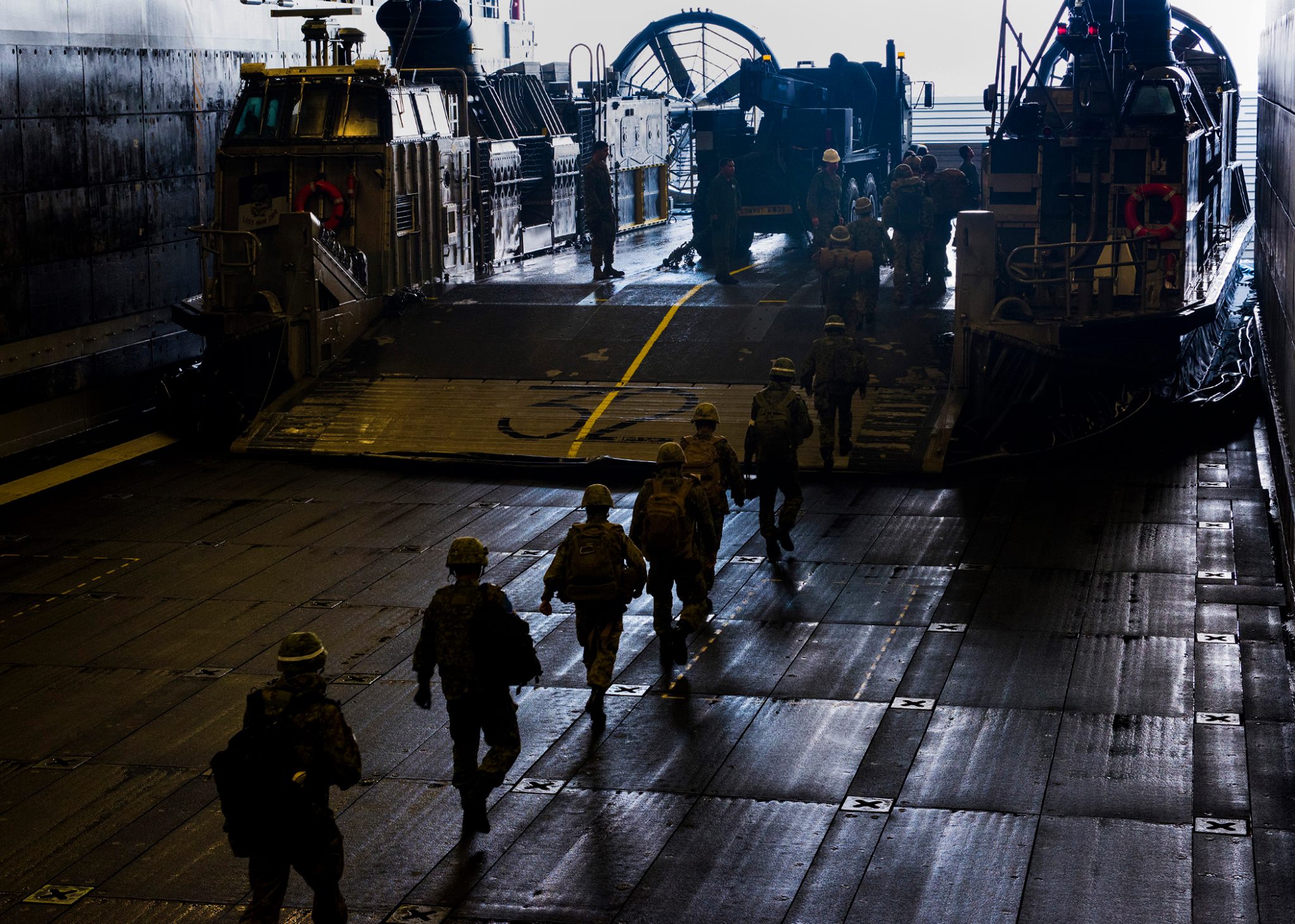
“We plan to build up our capabilities to defending islands,” Maj. Gen. Shinichi Aoki, the deputy chief of staff for operations with the Western Army, Japan Ground Self-Defense Force, said at a Feb. 26 press conference before the AAVs came ashore during exercise Iron Fist 2016. “Defending the remote islands is very important for our nation,” which he noted number some 2,500. The Western Army is based in Kumamoto, and is responsible for the defense of Kyushu and Okinawa.
About 150 Japanese troops boarded Somerset a week earlier to practice being at sea and landing ashore, with another 150 or so working and training ashore. Working with Marines of 1st Battalion, 4th Marine, the soldiers went ashore at San Clemente Island, where they also conducted a supporting arms exercise before planning the Feb. 26 amphibious landing. This year’s bilateral Iron Fist exercise was focused on “general island defense” operations, not on the new security posture, Aoki said, at times speaking in English. But as Japan adjusts to the new posture, “we’d have to work on that to harden our alliance and interoperability.”
The past decade has seen a significant change in that military-to-military relationship. “Our governments have pledged to strengthen the bonds of peace and friendship,” said Brig. Gen. David Coffman, I Marine Expeditionary Force deputy commander (I MEF), “and to uphold the principles of democracy, liberty and the rule of law.”
“This year, we are gaining experience… of a bilateral ship-to-shore, battalion-sized amphibious assault. This is a big deal,” Coffman said. “This training is a testament to the discipline and spirit of the fine warriors… and it’s very beneficial for both services.”
“Amphibious operations are vital to effective crisis-response support, regional security and deterrence – three things Japan and the U.S. have great interest in as Asia-Pacific maritime nations,” he said. The Iron Fist exercise is “paving the way for continued success for our coalition expeditionary force-in-readiness.” If and when needed, “we can work together to accomplish our mutual goals,” he added.
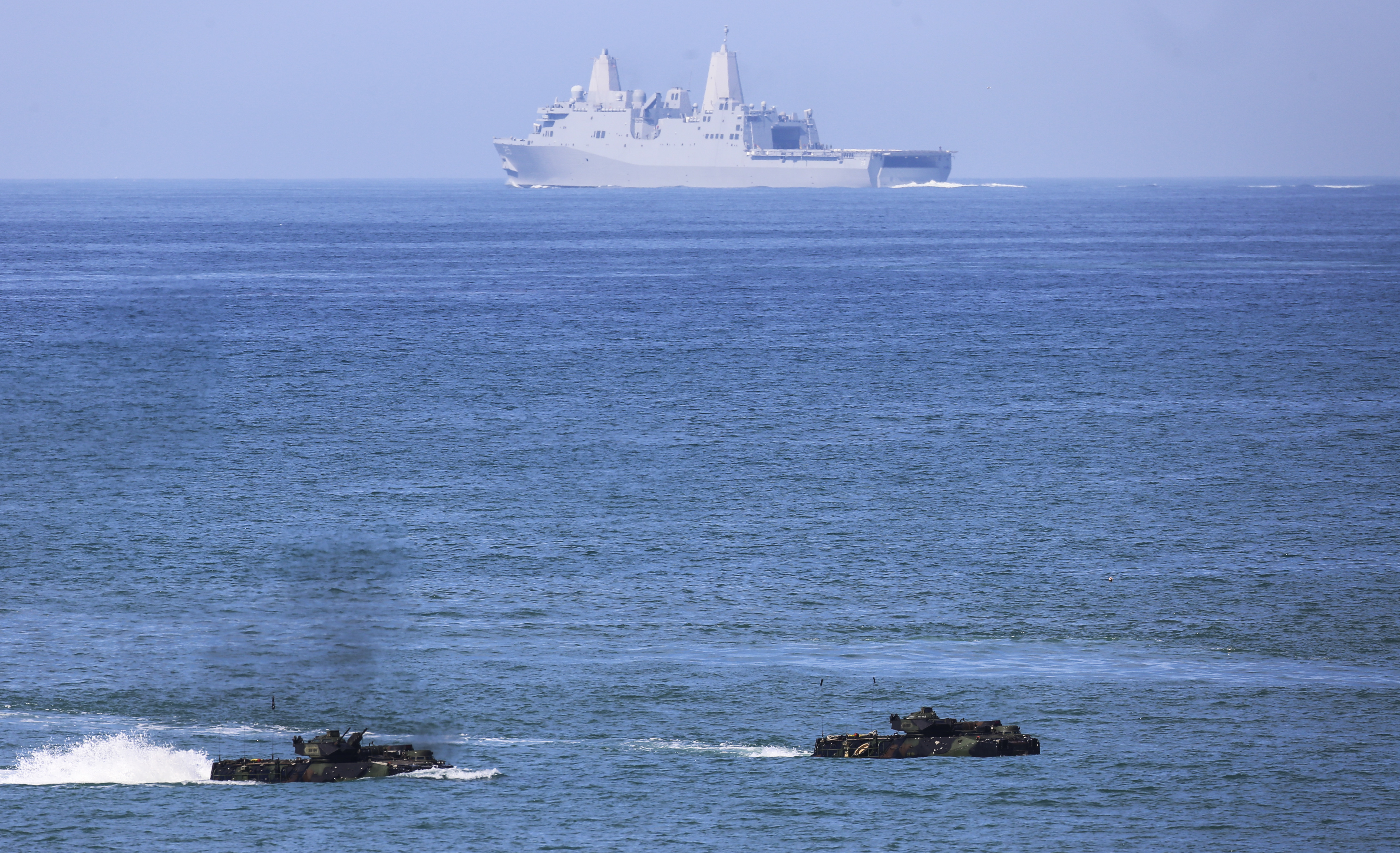
“Japan will stand up a new blue-green force called the Amphibious Rapid Deployment Brigade by 2018. Japan plans to buy the AAV-7, or amphibious assault vehicle, and the MV-22, which will give them the sea legs and reach to conduct amphibious missions. “This Iron Fist is a great opportunity for us to educate our personnel who will be in the unit with the AAV-7 and the MV-22,” Aoki said.
“For Japan, training with the Marines helps build more interoperability working with other militaries and even as a joint task force. Unlike operations inland, “amphibious operations require higher capability, because we’d have to coordinate with JMSDF and JASDF,” said Aoki, referring to the Japan Maritime Self-Defense Force and Japan Air Self-Defense Force. Iron Fist allows them “to directly observe and learn U.S. Marine Corps planning and operations skill.”
“Through this Iron Fist, we will continue to be beef up cooperation between Japan and the U.S.,” he added, speaking through a translator. “We learned a lot from the U.S. Marine Corps, and we have corrected many lessons from developing our capabilities.”
“The Camp Pendleton-based 11th Marine Expeditionary Unit worked with Aoki and his forces to develop the training scenarios. The beach landing was “the culminating event, over six weeks’ of work,” said Col. Clay Tipton, the 11th MEU commander. Marines and soldiers worked “side-by-side improving techniques, tactics and procedures” through more-complex training leading up to the combined landing operation.
“This year, the Marines and Japanese soldiers had different objectives but didn’t do separate landings, as done during the Dawn Blitz 2015 exercise at Camp Pendleton. “For Iron Fist, we are doing the combined action, where forces are operating in the same battlespace,” noted Coffman. “So different scenarios will require different command and control relationships for different ways to attack the problem, and we should be prepared for all of those different methods.”
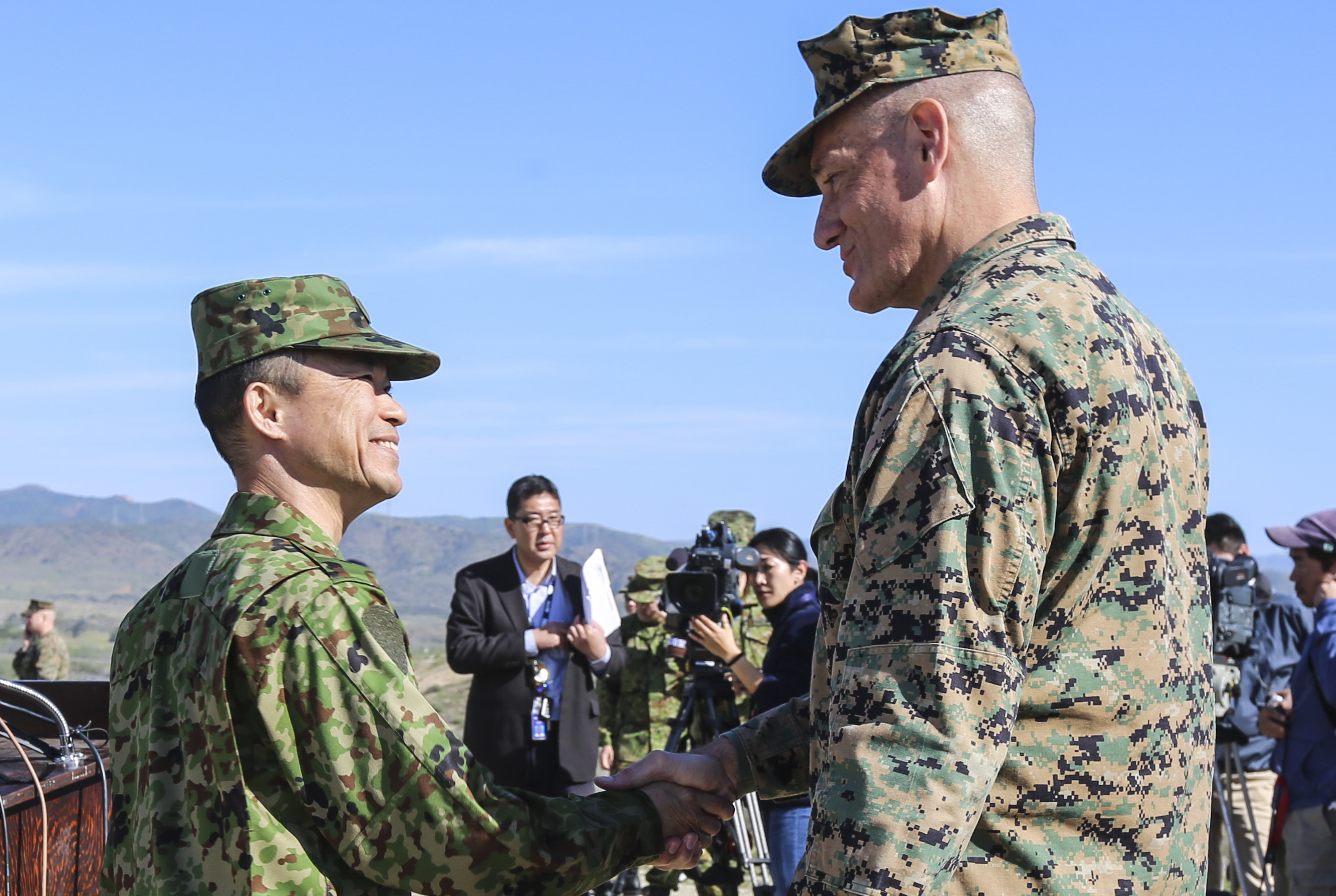
“It is a testament to our young soldiers and Marines, that although we don’t always get that exactly right, they seem to still be able to get the mission done,” he added.
Those missions include some of the basics, like setting up a security perimeter or loading casualties on aircraft. Marine and Navy instructors paired with translators and Japanese evaluators watched the soldiers on their techniques. One group tasked with evacuating a fellow “wounded” soldier loaded him on a gurney they then placed in an MV-22 nearby. Speed is critical to ensure wounded troops can survive that “golden hour” after an injury, said Navy Hospital Corpsman 1st Class (FMF) Benjamin Chapin, an instructor with Combat Logistics Battalion 11’s Health Services Platoon. So soldiers have to learn to stem blood loss, keep patients warm and determine who’s worse, or triage. Instructors also reminded soldiers to load patients head-first and place the gurneys on the racks inside the Osprey so the worst wounded are offloaded first when the aircraft lands at the medical unit.
As Ospreys launched and others landed, Japanese soldiers stretched in the dry brush and scrub along the landing zone. “It’s extremely important to defend our own islands,” said Sgt. 1st Class Satoshi Hashiguchi, a platoon sergeant with his face covered in black-and-green camouflage paint. Training together with the Marines, especially in their local training ranges and facilities, “is extremely important.”
Like many fellow soldiers, Hashiguchi participated in last year’s exercise, but this year he got to experience life at sea aboard Somerset. And he operated aboard the AAVs, observing Marines and seeing how they use those amtracs for amphibious assaults. “It has been very good training, so far,” he said.
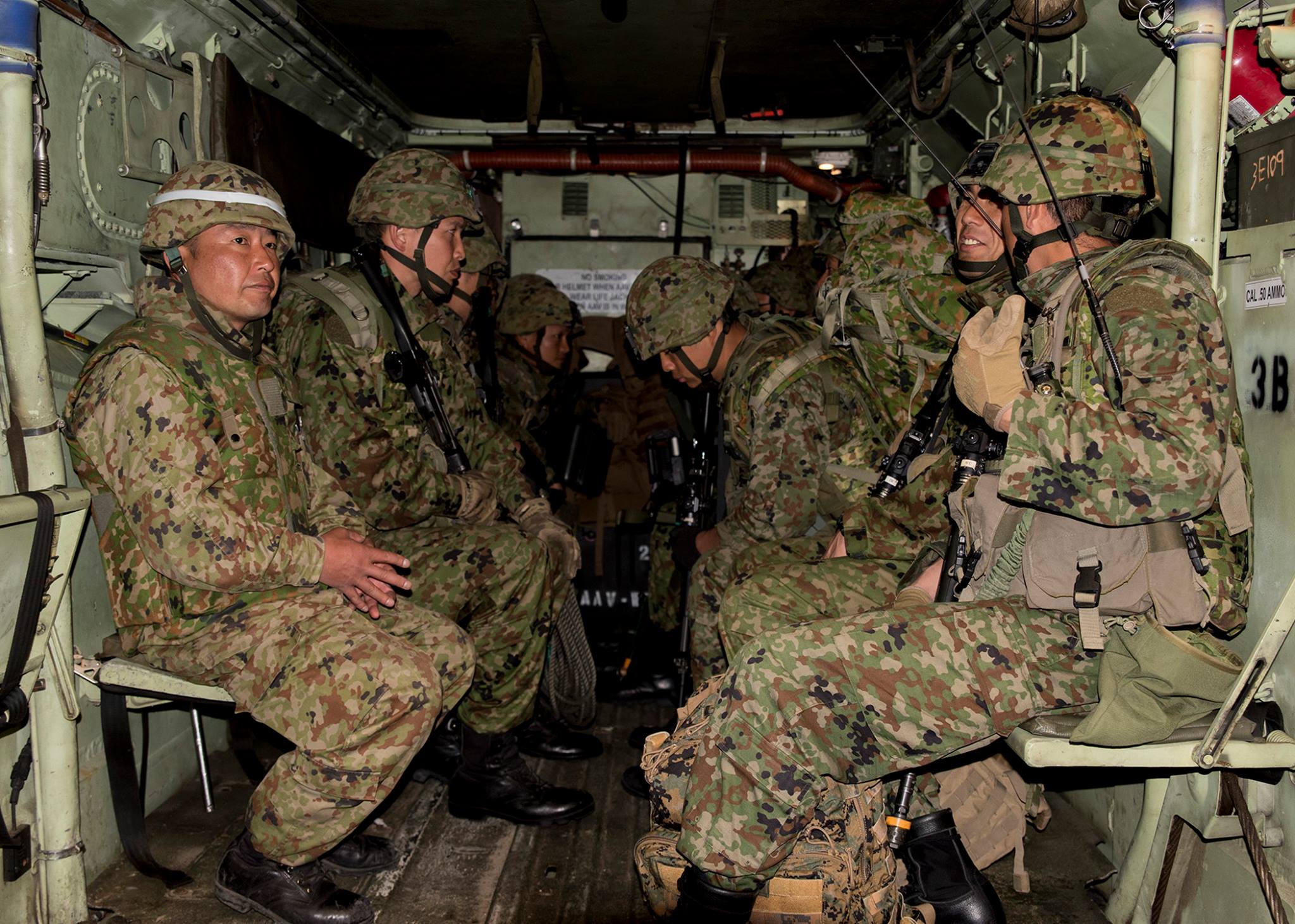
Military officials expect that training and relationships will continue to grow. “We have a lot of interest in the amphibious development” in Asia-Pacific, said Maj. Christopher Neal, a liaison with Japan-based III Marine Expeditionary Force. Neal, a CH-53E pilot by training, is one of three liaisons working with Western Army Infantry Regiment headquarters. The regiment, based near Sasebo, falls under the Western Army and is developing the Army Rapid Deployment Brigade.
“In a couple of years, it’ll be its own unit,” Neal said. It will include a ground control command headquarters that, “in an operational scenario, when something happens, it will serve as a coordination mechanism for a rapid response force.”





